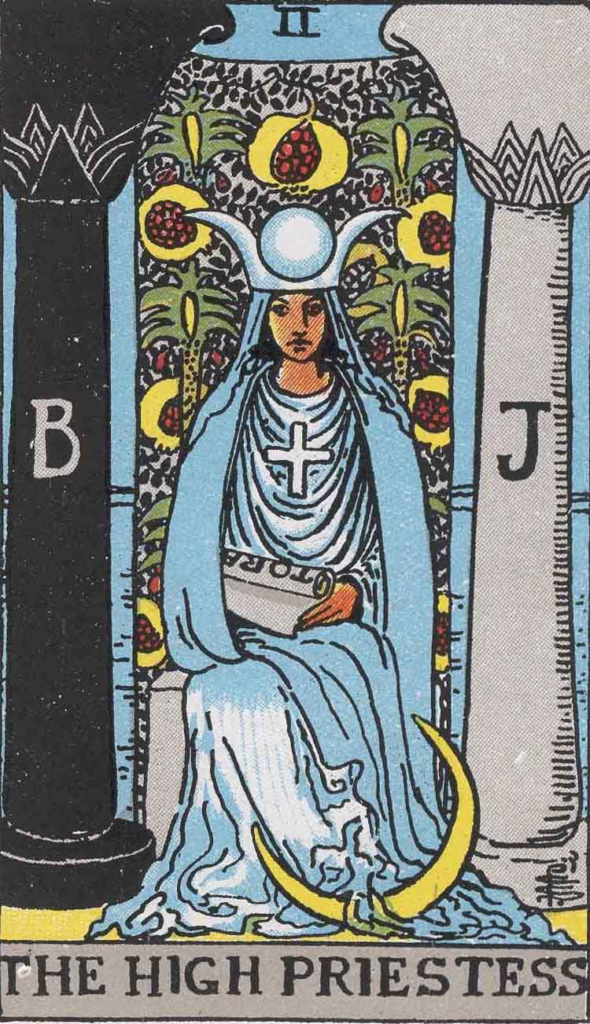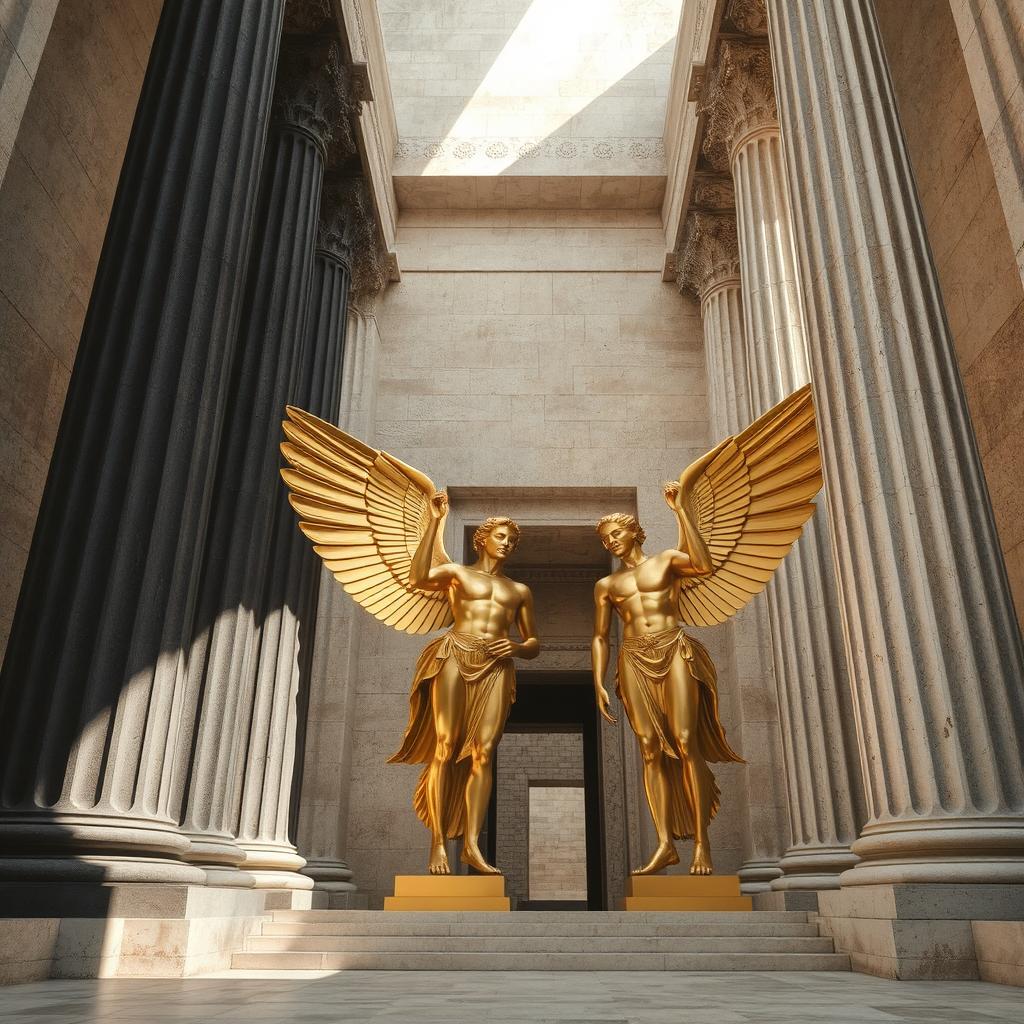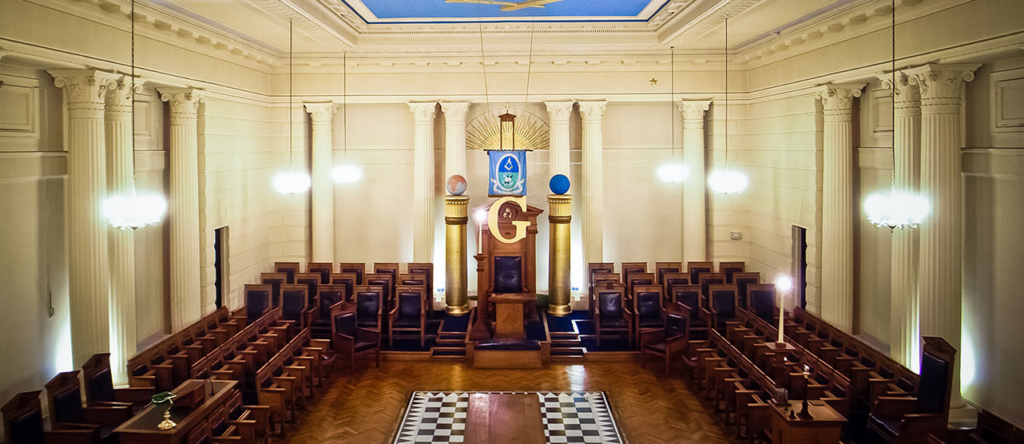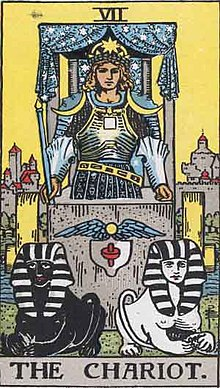
Have been to a ritual where there was a white column and a black column and no-one bothered to tell you what they mean? You might be entitled to compensation… just kidding.
So you might have come across these columns before. You see them on the High Priestess tarot card from Smith-Rider-Waite deck, labelled with characters that some erroneously think are hinting at a sexual mystery. Maybe there is no error, maybe they know that the letters BJ do not hint at a sexual practice at this particular time, but they bring it up anyway hoping to get one…
If you have been to a Gnostic Mass or a Also in any groups working deeply with ceremonial or Hermetic Order of the Golden Dawn themes, you will often notice two pillars at the sides of the east-facing altar, one black and the other white. These are known as Boaz and Jachin and are referenced in the bible. For years I was surprised that none of my fellow Magicians seemed to know or care what they symbolised. Their favourite comment was one was Yin and the other Yang and yet they even couldn’t agree which way round they were.

Here in this short, to the point article, I try to elucidate the meaning of these pillars. Where did they come from? What did they mean to the people who introduced them to the Western Esoteric tradition, what did they mean to those that perpetuated them and what do they mean to the modern practitioners today.
Before we proceed any further I would like to point out that the ch in Jachin is pronounced like the ch in Loch or German ich and the J has a y sound, like the j in Allelujah.
The Earliest Reference
For things that showed up in the Hermetic Order of the Golden Dawn, it is not uncommon to find references to them in the Bible. Yes, I’m sorry folks. With a lot of Ceremonial Magic, no matter how much we paganise it today, it had a Christian Origin and there’s no denying that.
The earliest references to Boaz and Jachin are found in the Hebrew Bible, specifically in the context of the construction of Solomon’s Temple. These two pillars are described in the First Book of Kings (1 Kings 7:15-22) and the Second Book of Chronicles (2 Chronicles 3:15-17).
So we will look at those verses in a sec, but remember that when they were introduced to ceremonial magic that the symbolism within magic might not reflect the beliefs from outside. I like to think about this as when effeminate gay men wear clothes associated with military figures, bikers, skinheads and construction workers. In some cases, there is a level of attraction to what is perceived as masculine, but sometimes it is to subvert the very masculinity that has been denied them. Sometimes I wonder if the use of biblical symbolism in ceremonial magic is to subvert the power of the religion back to the people of the religion rather than allow it to be vaulted in religious institutions such as churches.

Anyway, let’s look at the relevant bible verses:
“He cast two bronze pillars, each eighteen cubits (roughly 8m) high and twelve cubits (roughly 5.5m) in circumference. He also made two capitals of cast bronze to set on the tops of the pillars; each capital was five cubits (2.2m) high. A network of interwoven chains adorned the capitals on top of the pillars, seven for each capital. He made pomegranates in two rows encircling each network to decorate the capitals on top of the pillars. He did the same for each capital. The capitals on top of the pillars in the portico were in the shape of lilies, four cubits high (1.75m). On the capitals of both pillars, above the bowl-shaped part next to the network, were the two hundred pomegranates in rows all around. He erected the pillars at the portico of the temple. The pillar to the south he named Jakin, and the one to the north he named Boaz. The capitals on top were in the shape of lilies. And so the work on the pillars was completed.”
1 Kings 7:15-22 (NIV)
2 Chronicles 3:15-17 (NIV)
“In the front of the temple he made two pillars, which together were thirty-five cubits (15.5m) long, each with a capital on top measuring five cubits (2.2m). He made interwoven chains and put them on top of the pillars. He also made a hundred pomegranates and attached them to the chains. He erected the pillars in the front of the temple, one to the south and one to the north. The one to the south he named Jakin, and the one to the north he named Boaz.”
These passages describe the two bronze pillars that stood at the entrance of Solomon’s Temple in Jerusalem. Now there are two things to think about here. One is that Freemasonry involves allegorical ritual based around masonry and construction particularly that of the temple of Solomon so we can see how something as important as the pillars could be to Freemasons. We also recognise the huge impact they had on modern day ceremonial magic. Also, the second is that these pillars hold up the entranceway to the holy place. They symbolise approaching the divine through the power of King Solomon who built such a magnificent display. It was definitely a symbol of his strength and his power to allow his people into the house of their god. An entrance which would have been denied to those who were “unclean” such as women on their time of the month, men who had recently ejaculated, and anyone who wasn’t living according to the Israeli and Judaic law of the time, including Witches, those who speak to the dead and homosexuals. By the use of these pillars within our own spiritual practice is to subvert the power displayed by King Solomon and allow ourselves the right to permit entrance to sacred ground. We take the place of Solomon by erecting our own entrance to our own temple and permit to enter who we choose to permit.
Boaz was the name of the pillar on the left (north), and Jachin (or Jakin) was the name of the pillar on the right (south). The names are often interpreted symbolically, with Boaz possibly meaning “In Him is strength” and Jachin meaning “He will establish,” reflecting themes of divine strength and stability.
These references are the earliest known mentions of Boaz and Jachin, dating back to the biblical account estimated to be 10th century BCE. They have since become significant symbols in various traditions, including Freemasonry and their meaning has evolved.
Freemasonry
In Freemasonry, Boaz and Jachin are prominently featured as symbols of the entrance to King Solomon’s Temple and are incorporated into Masonic lodges. Note the entrance to UK grand lodge in Covent Garden having two massive pillars either side of the entrance.

They also often appear inside the lodge where sometimes in ritual one is decorated white and the other black.

They represent strength (Boaz) and establishment (Jachin), reflecting the stability and endurance of the Masonic order.
They are often depicted as the two pillars at the entrance of a Masonic lodge, symbolizing the passage from the profane world into the sacred space of spiritual enlightenment.
In some interpretations, they also represent the sun (Jachin) and moon (Boaz), further emphasizing their dualistic nature. For many astrological qabalists they will note that the middle pillar from the oft-maligned Malkuth that some consider profane to the divine light, one might attempt to ascend the Tree of Life through the sephirah associated with the moon, Yesod, and the sephirah associated with the sun, Tiphereth, where the initiate meets with divine light. Of course this practice very different to early Jewish Kabbalah where the Tree of Light is the flowing of divine light into creation rather than something to be ascended.
Freemasonry had a huge impact on the modern occult and pagan world, giving it many of its symbols such as the pentagram, the elemental association with the 4 directions and its connection with alchemy. It’s no wonder many of Freemasonry’s symbols such as Boaz and Jachin got lumbered with it.
Boaz and Jachin in Christian Cabala
I am yet to come across Boaz in Jachin as particularly significant in traditional Jewish Kabbalah, but they do seem relevant to the heavily bastardized Christian Cabala where they are associated with the Tree of Life.
Boaz corresponds to the Pillar of Severity (Geburah), representing judgment, restriction, and discipline.
Jachin corresponds to the Pillar of Mercy (Chesed), representing love, expansion, and benevolence.
The middle pillar, which balances these two, represents harmony and the path to spiritual ascent. To enter between the two pillars is to embrace balance.
For many modern groups that use Qabalah the pillars represent different pairs of sephiroth to symbolise the ritualist being in different initiatory temples. Sometimes different colours are used to represent which pair however often just black and white is used and it is simply understood which pair is intended.
Hod and Netzach are symbolised in order to pull the initiate into the temple of Yesod where they are initiated into the astral plane in this case the colours green and orange are used. Sometimes when doing this the duality which is explored is between emotions and logic or intelligence and intuition.
When they represent Geburah and Chesed/Gedulah, the intention is to pull the yesodic part of the soul (often the Ruakh) from Yesod to Tiphereth the next temple of initiation. Here the soul is introduced to the divine light and truth. The duality explored here is that of applied power and leadership by example or that of Severity and Mercy.
Finally, the pillars can represent Binah and Chokhmah to bring the initiate to the edge of duality so they can peer into the unity of Kether. Here the qualities associated with each pillar are transcendent and hard to conceive of. They are often described as Active and Passive or Yang and Yin. Although Chokhmah is often diagramized as grey, it is white for the purpose of this ritual where it is the opposite of black and where Kether, their unity, is all colours.
Eliphas Levi and the Yin Yang
Although not known for his accuracy Eliphas Levi introduces us to the concept of duality being associated with the pillars. In the chapter called “the columns of the temple” He writes the following in which equates the pillars with yin and yang.
Aleph (or Ox) is man and Beth (or House) is women. 1 is the principle, 2 is the verb, A is active, B is passive, the Unity is Boaz and the Duality is Jachin. In Fu Hsi’s trigrams Unity is Yang and Duality is Yin.
It is likely that from this the contemporary interpretation is drawn. However the comment “they are Yin and Yang” is extremely simplistic to the point where it might be considered inaccurate.
For Eliphas Levi the meaning of the pillars is also represented by the two snakes on Hermes Caduceus’s wand, the two sphinxes pulling the Chariot and the angels of the Ark of the Covenant. Eliphas Levi represents them all as one black, one white.

Boaz and Jachin in the Hermetic Order of the Golden Dawn
Boaz and Jachin may appear beforehand in Masonic ritual, but I am most aware of them right from the outset of the Hermetic Order of the Golden Dawn initiations.
The Hermetic Order of the Golden Dawn attempts to elucidate divine mysteries in people through initiation rituals. Similar to a short play where the initiate plays a part and they are exposed to the spiritual energies through the dramatic acting and symbolism of the sort of play. During this ritual the order brings them to the divine light that they seek and often connects it with various parts of their soul. The pillars are recreated for the purpose of the ritual (albeit not quite as large as in the biblical account) and they are referred to particularly in the neophyte ritual.
One slight difference here is that they are suddenly equated with the pillars of Hermes. Now the pillars of Hermes are likely more myth than actual, but there are some places where there have been some repositories of knowledge which may have been called the pillars of Hermes as a form of compliment to their completeness. These were two pillars one was said to be made of gold and the other of emerald (but again this was probably more allegory than fact) and each was said to contain scrolls of knowledge often ascribed to the god Thoth. Ascribing them to Thoth and Hermes was likely a polite way of saying they were full of wisdom and complete, rather than indicating that a god had anything to do with the wisdom contained in the actual pillars. Such a name, might have indicated that the keepers believed such a repository of knowledge could hardly exist, if it hadn’t been inspired by gods of wisdom. Alexander is said to have raided the pillars in Siwa and took their contents when building the city of Alexandria and placed them in the library of Alexandria where their information lay until the library was destroyed.
In Golden Dawn rituals you often hear references to the Two pillars of Hermes and Solomon. These are not 1 pillar of each, but the same two allegorical pillars syncretised.
These are represented as a black pillar and a white pillar they have the hieroglyphs from the chapters of the Book of the Dead (usually E. A. Wallis Budge’s version) 17th and 125th on them. These colours are described by Israel Regardie in his knowledge lecture the Pillars of there Hall of Truth (this is very likely a word for word recreation of a lecture written by W. W. Westcott. Black is on the left in the position most North and White is on the right in the position most South.
In the work of Pat and Chris Zelevski, it is noted that there are triangles on the pillars. Upon pointing East and the other West, they are supposed to indicate the potential for Tiphereth, symbolised by a 6-pointed, if only they were united.
They are also referred to as the pillars of Seth in knowledge lectures but the meaning of this is hard to elucidate. In a book called Antiquities of the Jews, Historian Josephus writes about Seth the third child of Adam. (Not the Egyptian god). Josephus writes that Seth’s descendants committed all their wisdom to 2 pillars. One made of stone and the other of brick. Each piece of wisdom was committed to both. The theory was that if the world was consumed by fire the brick would survive and if it was consumed by water the stone pillar would survive so between them the two pillars everything was preserved. Now I’m not sure whether this is the associated pillar but it is too similar in nature to the description of Hermes pillars to ignore.
It’s clear from most of the text that the place between the pillars indicates both balance AND the gateway to Occult knowledge. In the ritual, one of the officers, called the Hegemon, says the following:
My station is between the Two Pillars of Hermes and Solomon, and my face is towards the Cubical Altar of the Universe. My duty is to watch over the Gateway of Hidden Knowledge, for I am the Reconciler between Light and Darkness.
The Hegemon – Hermetic Order of the Golden Dawn 0=0 Neophyte ceremony
So we see the theme of the gateway come up once again, but the idea of perfect balance between Darkness in the West and Light in the east is a new idea. Normally each pillar is an extreme and between them is balance but as we look between the pillars ahead of us is light and behind us is dark so there is balance between extremes again, just like Yin and Yang, but this time the Yin is so far from the black pillar and Yang is so far from the white pillar.
Later in the same ritual the problems associated with imbalance, even unbalanced mercy, are expounded to reinforce the importance of balance before the initiate is reconciled by being brought to a place we already said was associated with balance, between the pillars. The initiate is brought here to instruct him on the secret of the grade. The initiate hears the following words:
“I now place you between the pillars of Hermes and Solomon in the symbolic gateway of Occult Wisdom.”
So once again the importance of balance is overstated being relevant in the whole process and the gateway to wisdom is mentioned again. It is likely that the writer of this ritual wanted you to understand balance itself is the gateway.
The initiate also hears many more associations when they are told by the Hierophant as the emphasis shifts to the concept of balance. Suddenly the pillars are opposites to each other again.
“The Pillars of Hermes and Solomon. On these are painted certain hieroglyphs from the 17th and 125th Chapters of the Book of the Dead. They are the symbols of the two powers of Day and Night, Love and Hate, Work and Rest, the subtle force of the loadstone and the eternal out-pouring and in-pouring of the heart of God… the throne of the Hegemon seated between the Columns is the Place of Balanced Power between the Ultimate Light and the Ultimate Darkness”
So as we see they symbolise opposites here. Each is opposite to the other and perhaps one of the Hermetic Order of the Golden Dawn’s first lessons is that balance between opposites is the door to Occult wisdom. Suddenly something interwoven throughout our lives can be made into a vehicle for spiritual development. Everything we do can be considered an opportunity to achieve a level of balance.
The Pillars in the Book of the Dead
Mostly taken from a lecture provided to us by Israel Regardie, which was probably originally written by William Wynn Westcott, called Pillars in the Hall of Truth. We are informed that the pillars are featured the 17th and 125th chapters of the Book of the Dead. They were most likely referring to Budge’s translation thereof.
In the 9th chapter of the Book of the Dead, the pillars are called the pillars of Shu. This would indicate they are the pillars that hold up the sky separating it from the earth. They are also called the pillars of the gods of dawning light. So we have this association with the introduction of the initiate to divine light. Finally, in the same chapter there is a reference to the two pillars the northern and south pillars of the Hall of Two Truths.
Alternatively, in Chapter 125 the pillars represent the doorway to which the deceased has been brought after he made claims that he had never sinned (a process through which everyone goes in the Egyptian underworld). It is in this hall where the soul of the deceased becomes equated with that of Osiris the resurrecting sun god so the soul would be dragged back up to life as Osiris re-rises. This also reflects part of the Hermetic Order of the Golden Dawn’s process, which is to bring an initiate to the dawning of a golden day where they are raised up spiritually as Osiris is raised from death to life.
Modern Interpretations
In modern occult and esoteric traditions, Boaz and Jachin are often imbued with symbolic meanings that extend way beyond their biblical origins. These two pillars are frequently associated with duality, balance, and the gateway to spiritual enlightenment.
In alchemical and Hermetic traditions, the pillars can be imbued with the associations of sulfur (Boaz) and mercury (Jachin), the two primary alchemical principles. However, this smells of that early 1900s desire to associate everything from the far-west to the far-east to make it seem like some white man’s occult order in London knew the secrets of all cultures across the globe. But in equating everything from extremely diverse cultures, a large amount of nuance was lost. This whiteman’s bastardization of other cultures often involved ignoring the parts that didn’t fit neatly and focusing on the parts that do fit. This equating every thing seemed lazy and it is my fear that yin and yang association is an example of this willful ignorance.
Obviously, the process of reconciling opposites to achieve the Great Work or spiritual transformation was the goal and this does share surprising similarity with uniting Shiva and Shakti and recognising that the true Dao is beyond yin and yang.
In psychological frameworks, Boaz and Jachin can also represent the duality between: the conscious and unconscious mind and the rational and intuitive aspects of the self. The struggle and reconciliation of opposing forces within the individual is part of the psychoanalytic goal.
Their interpretations vary across different systems, but some common themes emerge:
Symbolism of Duality, Balance of opposing but complementary forces, such as:
Yang and Yin
Masculine and Feminine (albeit in Victorian idealised expectations)
Active and Passive
Strength and Establishment (as suggested by their biblical meanings)
Severity and Mercy (in Kabbalistic traditions)
Freedom and Regulation
Together, they symbolize the balance of opposites, a central theme in many occult systems. This duality is often seen as necessary for harmony and spiritual progression.
In fact, for religious rituals like the Great Rite in Wicca and the Thelemic Gnostic Mass, it is not just the gateway to the divine which is dual but the divine itself. For example: the God and the Goddess, the Lady and the Lord, the Moon Goddess and the Horned God, Hadit and Nuit, and many others. A step toward the pillars is a step toward the divine.
The pillars are seen as guardians of the threshold, representing the passage from ignorance to knowledge or from the material world to the spiritual realm.
In ceremonial magic, they may be invoked or visualized as part of rituals to create sacred space or to balance opposing forces within the practitioner or to draw the initiate’s soul to a certain sephirah.
But the first and original meaning of the pillars was to hold open the gateway to the divine. A doorway such that all who were clean and appropriate could enter. A doorway we re-appropriate so that we can allow all entrance to divine, whether conformist, queer, male, female, sexual, chaste, rich, poor, Jewish or Gentile. In fact as I read the Hermetic Order of the Golden Dawn notes I see they call them the pillars of Hermes, of Seth and of Solomon. But I choose to believe is that they are the pillars of us, of the Neopagan movement opening the ancient gateway to the temple.

Leave a Reply